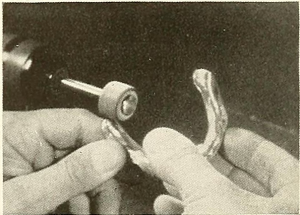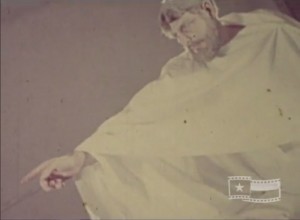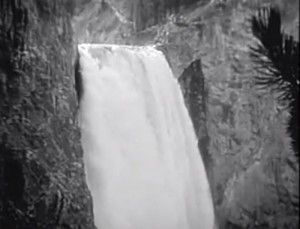"documentario scientifico"/scientific documentary

"The term, "perfect," is not one to be given lightly, but The Ackley Lower Impression Technic, a dental study, earns such comment, because there is no other word that fits. Harry Coleman, the producer, here shows a complete mastery of the camera. The film, of greatest interest to dental technicians, carries brief, double exposed titles that make each progressive step thoroughly clear to those versed in the phraseology. The titles appear at the proper time, superimposed upon the scene but out of the field of action, thus serving as a visual commentary. To anybody who is interested in dental filming, this movie might well serve as a model of a technical film, for it features extreme closeups, work in areas of the mouth difficult to film and a lighting technique indicative of real study and much experience. The exposure, especially important in showing the slight variations of color in parts of the mouth, is unusually accurate. Rarely does one see so satisfying an accomplishment in films of this specialized type." Movie Makers, Dec. 1941, 564.
"The Workshop trains physically handicapped people over school age. Activities featured are the General Committee at work - ladies seated around a table; a medical inspection - boys are weighed and have their chests, throats and limbs examined; all stages of book - binding; dinner time in the kitchen and the canteen; recreation; table - tennis, cards, reading, sewing, bagatelle, etc; needlework and embroidery room - women sewing at a long table; more scenes in the bindery; men busy in a leather workshop; and finally (in colour) a display of finished goods, and groups of workers, outside in the yard." (NWFA Online Archive)

"This experimental film, made by Kenneth Anthony in the late 1960s, records the story of Adam and Eve. It opens with chimpanzees and recreates Michaelangelo’s The Creation of Man. The production follows the traditional telling of the Biblical creation story. Eve accepts an apple, gives it to Adam, and God rebukes the two humans. The rest of the film is a collection of shots: a protest march, a swimsuit competition in a beauty pageant, a demolition derby, a Foreign Legion ceremony, indications of space exploration, and a photography exhibit, among others. These shots may not have been filmed by Anthony and may have been stock footage as they appear to include words in French. According to Anthony, the film was meant to be projected on multiple screens. It seems likely that the story of Adam and Eve would have been on a main screen with the shots from the latter half of the film projected onto accompanying screen or screens" Texas Archive of the Moving Image.
Película argumental en la que un adolescente enamorado de una artista descubre que está no merece sus desvelos y vuelve a su vida normal de joven estudiante.
Fiction film in which a teenager in love with an artist discovers she is not worth losing sleep over, and the goes back to his regular young student life.
"One of the most difficult of amateur subjects, a record of a child's vacation, is presented most ably in Adirondack Adventure, by Frank Gunnell, ACL. The photography was a joy to behold and showed quite clearly that a great deal of care and experience was back of it. Fine outdoor lighting, which made the most of every scene, predominated. The continuity of this competent picture was developed in such a fashion as to feature Mr. Gunnell's small son naturally and unobtrusively. Incidents which make up the picture are handled clearly and yet with a light touch. Only a movie maker would appreciate the fact that the sequences were far from casual but, instead, were staged carefully. The real charm of a summer vacation has been preserved in this fine picture." Movie Makers, Dec. 1935, 534.
"Footage of Canada and Alaska shot by Floyd Henry Wells, a retired salesman and a member of the Wally Byam Caravan Club of Airstream trailers" Human Studies Film Archives, Smithsonian Museum.

"An eight week Western camping trip in the summer of 1936 by seven boys from the Hartford, Connecticut area, under the leadership of Ken Strong, a Hartford Seminary graduate. Filmed by then teenage amateur movie maker Robbins Barstow (1919-2010)." Center for Home Movies.
"a burlesque on “Sherlock Holmes” (HMHT 1933: 446).
Total Pages: 299